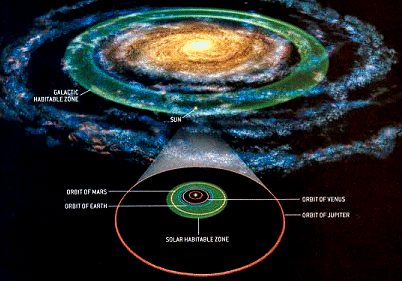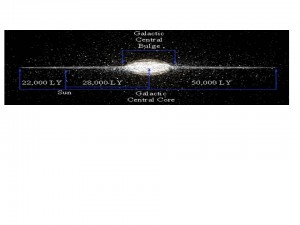 While we rotate around our own axis of myopic concerns, programmed to be first-class consumers, and culled like sheep by corporate America, we unknowingly rotate with the earth eastward on a 23.5° tilt at somewhere around 1000 miles per hour, at the same time mostly unaware of zipping around the sun leaving no sonic boom at 67,000 miles per hour. And we are oblivious passengers in tow, as our whole solar system moves around our galactic core at 155 miles per second in a clockwise motion.
While we rotate around our own axis of myopic concerns, programmed to be first-class consumers, and culled like sheep by corporate America, we unknowingly rotate with the earth eastward on a 23.5° tilt at somewhere around 1000 miles per hour, at the same time mostly unaware of zipping around the sun leaving no sonic boom at 67,000 miles per hour. And we are oblivious passengers in tow, as our whole solar system moves around our galactic core at 155 miles per second in a clockwise motion.
During that orbit of 225 million years, your 2 million, 500 thousandth reincarnation will have occurred, though you might well be a cockroach. After all, cockroaches have survived with little change since the time of dinosaurs.
At any rate more and more scientists believe they now know where they might generally search for life in our galaxy, at least of the complex variety. That may be a bit presumptuous with the immense limitations on our means of interstellar travel, but more advanced neighbors probably already teach this geography to their children, and identify other stellar systems of life for their eager students.
Just down and beyond our solar block, we have identified other planets capable of complex life. Using ourselves as a model, we have posited so-called “Goldilocks” zones that are favorable to life. As the image indicates, Earth is smack-dab in the middle of the habitable zone in our own solar system. Mars and Venus happen to be peripherals in that zone, uninhabitable due to a lack of a protective magnetic field and/or a viable atmosphere. Scientists do not know when these conditions came about.
Looking out like cosmologists, we have hypothesized a habitable ring around our galaxy within which conditions are best suited for complex life, at least as we know it. The so-called galactic habitable zone (GHZ) was first proposed in 1991 by Guillermo Gonzalez of Iowa State University and Donald Brownlee and Peter Ward of Washington University, and endorsed by others.
Outside the GHZ, various factors make the existence of multi-cellular life difficult, if not impossible. The current GHZ is said to extend from 23,000 to 29,000 light-years (LY) from the galactic center, composed of stars that formed between 4 and 8 billion years ago, and it’s all widening with time due to expansion of the universe.

The inner area, within the 23,000 LY ring, is beset by threats to creatures like us: nearby sources of harmful radiation, including cosmic rays, gamma rays, and x-rays coming from supernovae and from their resulting neutron stars and black holes. It is in a state of flux, disbursing deadly high-energy bursts that would quickly destroy Earth’s barriers, including our magnetic field and our protective ozone layer, rendering us cinders.
The closer to the galactic center, the more severe is the threat. In the center lurks a super-massive black hole, 4.1 million times the mass of our sun. Such a phenomena plus the combined gravity of rapidly orbiting stars near the event horizon would, at the least, perturb comets in the Oort Cloud, circling the outer limit of our solar system, and set comets hurling toward us.
Beyond 29,000 light years, there is a dearth of heavy element stars, a condition required for planets, being made of heavier elements like ourselves. Studies of extrasolar planets indicate that metal-rich stars are most likely to have planets orbiting around them.
| Over 95 percent of stars in the Galaxy, according to Gonzalez, would not be able to support habitable planets because their rotation is not synchronized with the rotation of the galaxy’s spiral arms. Spiral arms are troubled areas because of the density of gases and interstellar matter, which lead to the formation of new stars. Such processes breed intense radiation and gravitation, causing perturbations similar to the galaxy’s center. |
Then too, our Sun revolves at the same rate as the Galaxy’s spiral-arm rotation. This synchronization prevents our Solar system from crossing a spiral arm too often.
Nevertheless, our passage around the galactic core will not be without close encounters. Vadim Bobylev of the Pulkovo Astronomical Observatory in St. Petersburg calculates that the likelihood of an impact between Gliese 710 and the outer edge of our solar system is some 86%. Sixty percent the size of the sun, its distance will dwindle from 64 light years away to 1 light year, becoming as bright as Antares. It could very well disrupt planetary orbits and your dinner, sending a shower of comets and asteroids hurdling toward the Earth. Bobylev says we have 1.5 million years to prepare, a mere second in cosmic time.
What is the point of all these ruminations about a future we’ll never see?
My response would be that it is a matter of perspective, seeing how insignificant we are compared to the grand scheme of things, a scope beyond our navels.
We are one fly speck among trillions, most likely one inhabited fly speck among tens of millions.
What do you think?
————————————————————————————————–
Follow more from this author on Facebook here @ ——> Common Good




